Key Insights
- The API3 protocol provides transparent and accurate data feeds to consumers.
- Through thoughtful governance, API consumers are protected against API malfunctions.
- API3 allows data providers to expose their data to consumers without middlemen.
- The real test for API3 will be gaining sustained adoption from consumers.
What’s New in Oracle Land?
Be it financial, weather, or sensor data, decentralized applications (dApps) need accurate, real-world data. When implementing dApps, Web3 developers use on-chain APIs — called oracles — as data feeds for smart contracts. Most oracle solutions act as middlemen between data providers and consumers (e.g., dApps), i.e., they license data providers and serve data to consumers.
The API3 protocol allows data providers to run oracle nodes themselves, thus eliminating middlemen. Due to no middlemen, data providers can no longer remain anonymous; instead, they are accountable and may face repercussions should inaccurate data feeds be delivered to consumers.
API3 differentiates itself from existing oracle solutions in two ways. First, it provides full transparency in terms of the data feeds provisioned to consumers. Second, it offers on-chain service coverage in the event of API malfunctions. How does the technology behind API3 work?
Technology in a Nutshell
API3 allows data providers to directly expose their data to smart contracts. To accommodate developers’ needs, API3 has a modular design with three layers built on top of each other: the protocol layer, the middle layer, and the top layer.
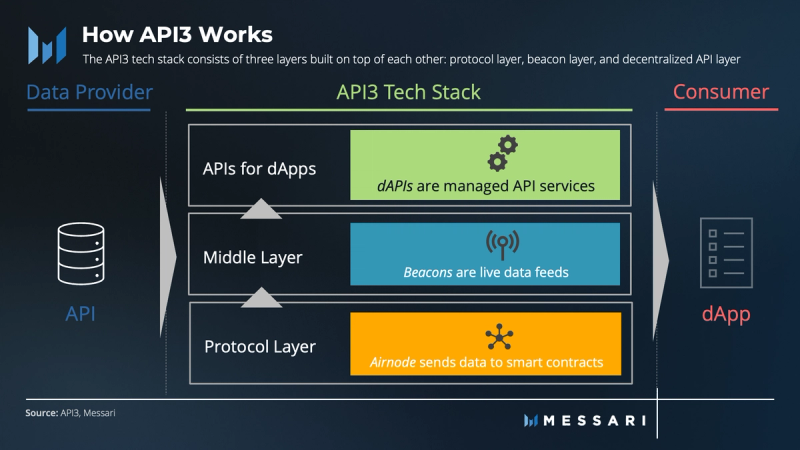
Depending on development needs, a dApp can consume API3 services at each of the three layers.
The lowest layer is the API3 protocol layer, where data providers register the data feeds they serve. Authorized dApps get data via a serverless oracle — the Airnode technology. In simple terms, Airnode pulls data when dApps request it. That is, Airnode is used by data providers to send data to smart contracts. It requires no “know-how” to operate and no day-to-day node maintenance. As of September 13, 2022, Airnode has been deployed on 13 chains and is EVM-chain compatible.
The middle layer consists of the API3 beacons built on top of Airnode. Each beacon is a live data feed, where data from API providers is consistently put on-chain according to certain parameters (e.g., every 1% price change). Typical examples of beacons are forex, stocks or commodities data.
A beacon is maintained so protocols can simply read data or actively request it. Beacons allow API providers to respond to dApp requests — beacons create data feeds and signal the Airnode when to transmit data to smart contracts. Beacons abstract away complexities of the underlying Airnode layer; as a result, beacons allow developers to get API3 data without dealing with the technical intricacies of a specific Airnode protocol.
At the top layer are the APIs for dApps (dAPI). A dAPI is essentially a mapping where a name such as “BTC-USD price” is mapped to an ID of a beacon. API3 can point that mapping towards a different beacon (or set of beacons), which makes dAPI an actively managed service. dAPI is the highest-level solution for builders, hence the default choice for dApp implementation.
As alternative to the top layer, dApps can choose to access the protocol layer for situations when the data depends on parameters. Think, for instance, of situations like weather data that depends on location or when the API response isn’t consistent, e.g., random number data in which the response is different for each request.
Tokenomics
The native token, API3, is used for two main purposes:
- Governance: the API3 token aligns to align incentives between various stakeholders in the API3 protocol and facilitates smooth operations.
- Staking: the API3 token can be staked in return for rewards and community voting power.
Tokenholders who stake their API3 receive a pro rata share of the protocol staking rewards. These rewards are paid in exchange for taking the risk of slashing should dAPI malfunctions occur. At the same time, data providers who operate API3 oracle nodes are not required to hold the API3 token.
Governance
To decentralize the governance of dAPIs and of the project as a whole, API3 is governed by a non-profit DAO. The API3 DAO oversees the entire network and is responsible for steering and executing the API3 project. The governance is open — all stakeholders can directly participate upon staking API3 tokens.

Source: API3 Whitepaper
The DAO votes on dAPI governance, staking incentives, collateralization for an on-chain service coverage fund, and disbursement of funds held in the DAO governance contract (USDC and API3 tokens). The DAO’s treasury is directly interactive, i.e., it does not require the action of any intermediary, multisig, or individual to transfer tokens upon a successful on-chain vote. This is achieved via on-chain DAO resolution function calls, referencing an IPFS hash which holds each full proposal text. A prominent example of an API3 DAO vote is to select beacon data providers to ensure and maintain accurate data feeds.
Additionally, the DAO awards grants towards the API3 ecosystem. Granular tasks are conducted through hierarchical sub-DAO team structures for scalable governance. Any individual or sub-DAO team running the protocol’s day-to-day operations may apply for a DAO grant. DAO proposals, including proposals for such grants, are permissionless provided one has, or has been delegated, sufficient voting power.
Monetization
There are two monetization mechanisms used by API3. First, when using beacons and dAPIs, dApps will pay in USDC. API3 will then pay out API data providers in either USDC or fiat based on their preference. Upon completing a payment, dApps receive a whitelisting that allows them to read their data feed. At the same time, dApps receive a service coverage policy that allows them to make claims in case of potential dAPI malfunctions.
Second, at the Airnode level, dApps may subscribe directly to an Airnode and make protocol level requests to it. While this is not a requirement in the case of free API3 services, a smart contract can be used to collect token payments in return for access on a protocol level.
Service Coverage & Slashing
API3 offers service coverage against dAPI malfunction to mitigate potential security, governance, and reliability issues. For instance, API3 might compensate dApps for API downtimes or data feed inaccuracies. When a dApp subscribes to a dAPI, a specific service coverage is issued based on the potential malfunction risks and the quality and quantity of data being transmitted.
API3 service coverage starts with the DAO choosing what data to serve, curating reliable data providers, and deciding to cover them. DAO members have “skin in the game”: in case of a dAPI failure, stakers get slashed, and the funds are used to pay claims. Since the staking pool pays out claims, it incentivizes the DAO to govern for more security. DAO members are directly incentivized to optimize decision making, such as not onboarding unreliable API providers. In this sense, dAPI governance manages the budget and incentivizes the DAO to maintain data integrity.
When a malfunction occurs, an on-chain service coverage claim is made. Claims arrive at API3 as a first instance. The potential outcomes are approval, counter-offer or decline. Straightforward claims are generally approved and paid out directly by the DAO using API3 tokens. For more complex cases that require escalation, API3 uses an on-chain court system — Kleros — to arbitrate claims payouts. Put simply, Kleros can slash API3 on the basis of facts presented to them. In this way, Kleros adds yet another layer of decentralization to the service coverage and enables fair treatment to dApps utilizing the API3 data feed.
Token Distribution
As of September 13, 2022, the total supply of API3 tokens was 115 million. Out of this total supply, 100 million API3 was initially allocated in November 2020, and the remaining 15 million API3 has been minted as staking rewards to date.
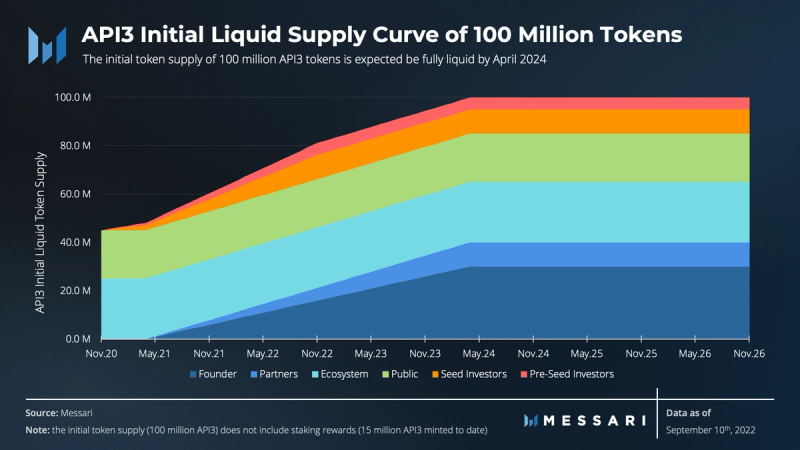
API3’s initial token distribution launched in November 2020 on Mesa DEX, a decentralized exchange using a batch auction mechanism. Anyone could participate in the auction, in which 20 million API3 tokens — 20% of the 100 million API3 initial supply — were sold. The complete breakdown of the initial supply of API3 and the scheduled distribution of API3 tokens is as follows:
- 30 million (30%) for the API3 founders and team vested over three years with a six-month cliff.
- 25 million (25%) for the API3 DAO to build the project’s community and ecosystem vested over three years with a six-month cliff. These tokens are used for grants to builders, for steering the direction of the project, and for driving growth. The funds can be accessed based on a governance vote that requires a 50% majority).
- 20 million (20%) for public investors unlocked after the initial Mesa DEX offering.
- 10 million (10%) for API3 partners (e.g., data providers) vested over three years with a six-month cliff.
- 10 million (10%) for seed investors vested over two years.
- 5 million (5%) for pre-seed investors vest over two years.
Inflation & Staking Rewards
To secure the network through staking, API3 maintains an inflationary issuance of staking rewards. The staked tokens are primarily used as collateral in the on-chain service coverage fund. If the non-profit API3 DAO has excess revenue after subtracting all their costs, they use this excess revenue to buy API3 tokens that are afterwards burned. Similarly, any USDC left over from operations will be used to buy API3 from the open market and burn it.
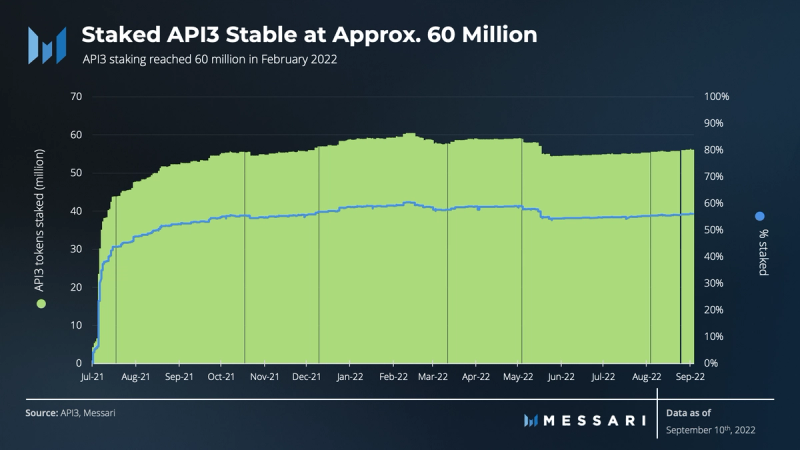
As of September 13, 2022, there are 5,362 actively staking wallets. Approximately 60% of the total API3 supply has been staked since Q3 2021. This percentage has held relatively stable despite the overall market downturn and inherent pressure to unstake and liquidate. The downturn also corresponded to a drop in APR to below 6% in May 2022, down from the top level 45% APR in August 2021.
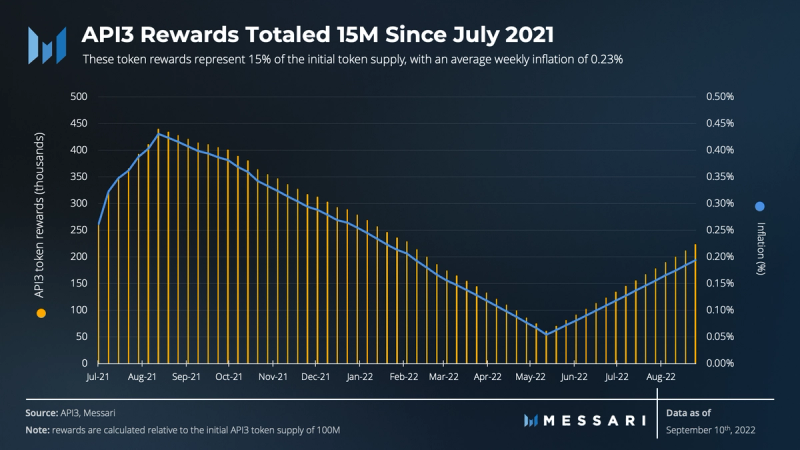
Subsequently, API3 rewards dropped in May 2022, followed by a recent rebound. In total, over 15 million API3 tokens have been awarded for staking since July 2021. These rewards come from an average of 0.23% weekly inflation since July 2021. This inflation rate is calculated using the staking pool size as a percentage of the total supply that is set by the API3 DAO. If the target is met, APR decreases by 1% each week. If the target is not met, APR increases by 1% each week. Staking rewards are paid out weekly, and are locked for one year after they have been paid.
Notable Events & Milestones
The latest Airnode version (V0.7) was released in September 2022. API3 also released the API QRNG to its platform in May 2022. The API3 QRNG is based on the ANU Quantum Numbers (AQN) API and is uniquely able to provide truly random numbers to smart contracts. From a security standpoint, to optimally address the Sybil attack risk, it is critical to be able to generate truly random keys – API3 QRNG is enabling that, being the gold standard for random number generation.
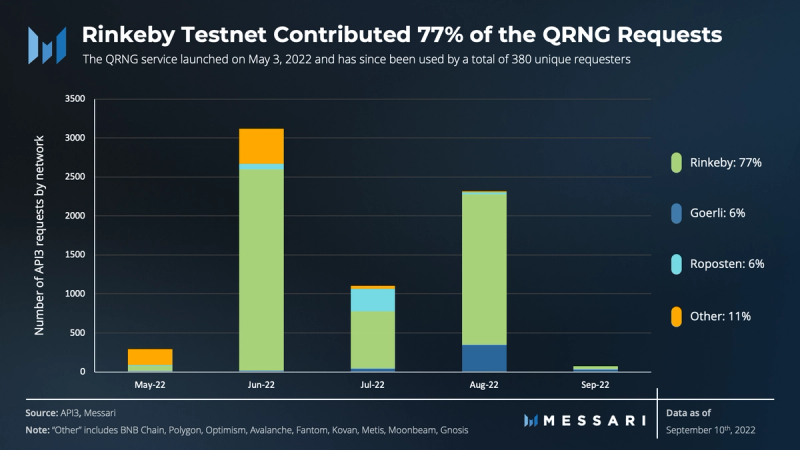
QRNG itself is free of charge, although users need to pay gas fees for calling the API. API3 QRNG is currently available on 13 blockchain platforms. Since May 2022, the Rinkeby testnet contributed 77% of the total QRNG requests coming from a total of 380 unique requesters.
The launch of single-source dAPI feeds on Polygon, BNB Chain, Avalanche, and RSK has been announced in July 2022. Multi-source feeds are expected to be released in the near future.
As of September 13, 2022, API3 has onboarded a total of 179 data providers. Notably, 169 of them were onboarded on Q2–Q3 2021 due to the API3 team’s priority to grow their API provider base. As of late, the team has been focused on curating data feeds by relying on the current API providers rather than onboarding new API providers. Quality prevails quantity.
According to API3’s roadmap, the main goal is essentially to offer On-Chain-Data-as-a-Service in a fully automated way. To achieve this, the API3 marketplace will offer consumers a means to visualize all available APIs and pay for services using a Web3 wallet. Upon payment, consumers will be automatically whitelisted for their data access using their respective chain. Additionally, their service coverage policy will be created on Ethereum Mainnet and used to initiate claims in the event of potential dAPI failure and resulting damages. Further milestones
API3 plans additional platform features such as aggregated data feeds, automated Web3 payments, automated whitelisting, automated coverage policy creatio, making multi-source dAPIs available on as many EVM chains as possible, including Solana and Near. In addition, cross-chain subscriptions may open up market opportunities through further chain compatibility.
Competition & Risks
In terms of competition, Chainlink is the most dominant oracle solution right now with 1025+ oracle networks and 1400+ total projects in its ecosystem. That may be explained by Chainlink becoming essentially the backbone for the DeFi sector with leading projects such as Aave, Compound, and Synthetix all relying on their network for off-chain data. Chainlink appears to be the only oracle platform with consistent active user growth, given that API3, Band, Ocean, and other oracles seem to have plateaued after an initial steep growth at launch.
Competing against established oracle solutions appears to be a difficult endeavor for API3. However, traction may come from API3 being the only first-party solution in the market serving increased user needs on transparency, data reliability, and service coverage.
In terms of risks, API3 has a complex tech stack due to its nature as an integration solution and may be prone to outages when relying on centralized infrastructure providers. API3 proactively addresses potential outages by building redundancy in RPC service providers. Depending on the chain these RPC service providers include Infura, Alchemy and, if applicable, Pocket Network as a decentralized RPC addition. The selected providers used by dAPIs are, in turn, required to use several RPC providers. Airnodes can be configured with multiple providers, as well as different providers for each chain. For Airnodes to fail, all the service providers would have to go down simultaneously.
Based on their goals, API providers may still prefer third-party solutions, where they could keep their anonymity. If API providers run their nodes on third-party solutions such as Chainlink, they would need to maintain the node and cover operational costs, as opposed to just using Airnode.
Resolving complex disputes and establishing the ground truth may also be cumbersome, especially when human subjectivity is involved. While Kleros is being used as an on-chain court system to arbitrate the second stage of claims. Especially difficult to handle are those cases where there’s no suitable way to measure the severity of an event in terms of its dollar-impact.
These complex situations may reveal the tradeoffs of trying to remove middlemen: as dApps have incentives to overestimate their claims, the API3 DAO may want to keep payouts as lean as possible. Hence, an open question is to what extent dispute resolution can be done in a fair and sustainable manner for all parties.
A further risk related to service coverage claims is token selling. Since claims are paid in API3 tokens, claimants receiving API3 compensations may sell those tokens to recover damages, resulting in further price volatility. Because dAPIs with too many malfunctions may further hurt the token, there’s an even greater need to maintain dAPI integrity through careful DAO governance.
Conclusion
API3 is an emerging technology in the Web3 oracle infrastructure. It differentiates itself from existing oracle solutions by allowing API providers to run oracle nodes themselves and by providing full transparency in terms of data feeds provisioned to consumers. Thus far, no other oracles offer this level of data transparency in addition to on-chain service coverage.
Being a first mover in terms of transparency and service coverage, API3 plays a significant role in the technical advancement of decentralized oracle solutions. Needless to say, API3 is still in its early days as a project. The real test for API3 is gaining sustainable traction and wide-scale community from consumers requiring accurate data feeds.
Let us know what you loved about the report, what may be missing, or share any other feedback by filling out this short form.





















